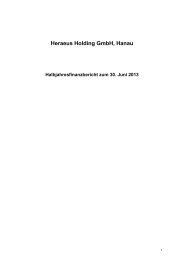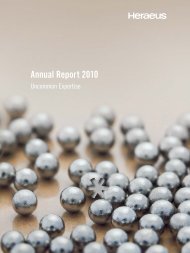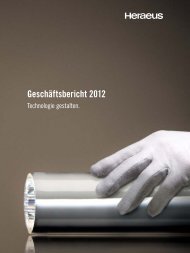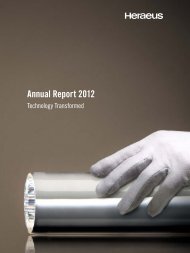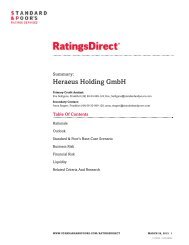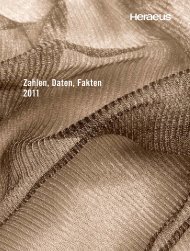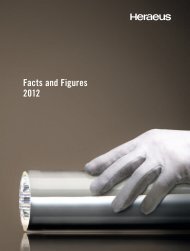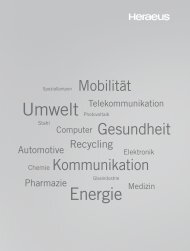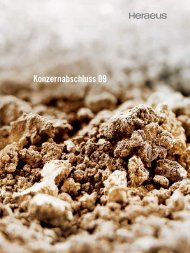English
English
English
Create successful ePaper yourself
Turn your PDF publications into a flip-book with our unique Google optimized e-Paper software.
MATERIALS<br />
Ceramic colors make<br />
life more beautiful<br />
Elegant decorations on glass and ceramics:<br />
a formula for success from Heraeus<br />
Vibrant colors and artistic decorative patterns are common on tableware, glass and tile. And regardless of the form –<br />
plate or tea cup, tile or drinking glass, bottle or pitcher – the demands placed on high-quality decorations continue to rise<br />
steadily. Heraeus was already a leading developer of ceramic colors back in 1896, and today creates innovative products<br />
that make modern decoration on glass and ceramic wares possible.<br />
Villeroy & Boch, Samarah Purpur.<br />
Things are very different today from the way they<br />
were in our grandparents’ time. Bright colors<br />
and precious metals must now meet tougher<br />
requirements. They have to hold up under<br />
constant use in everyday life and be able to<br />
withstand the dishwasher and microwave,<br />
as well as resisting scratches and abrasions.<br />
In addition, decorative materials for glass and<br />
porcelain need to meet increasingly stringent<br />
legal requirements regarding heavy metal content<br />
and release. There are legal limits on lead and cadmium<br />
content, thus lead-free colors cannot exceed a lead content<br />
of 600 ppm (= 0.06%). In the USA, only lead-free<br />
20<br />
ceramic systems may be used<br />
to decorate tableware. This<br />
poses a huge challenge<br />
for the developers at<br />
Heraeus, because lead<br />
is the key component<br />
responsible for luster<br />
and brilliance in fired<br />
colors.<br />
“Whether it’s dishwasher<br />
safe or lead-free, developers have put a lot<br />
of work into finding the right mixture. From the outside,<br />
people can’t see how complex the decoration is on the<br />
inside,” states Peer Hesse, Head of Development for<br />
Precious Metal Colors at Heraeus. Ceramic colors are<br />
comprised of a mixture of several components that are<br />
fired onto glass or ceramics. They need to be customized<br />
to suit the individual color application method and<br />
yield the best possible results after firing. Precious<br />
metal preparations consist of soluble precious<br />
metal compounds or precious metal powders,<br />
organometallic bonding agents as well as resins<br />
and solvents. Bright colors are composed of pigments<br />
for coloration – usually metal oxides – and<br />
a colorless, glasslike melting component (flux).<br />
The flux coats the pigment particles and affixes<br />
them to the underlayer. After firing, the pigments are<br />
encased in a glassy layer. Flux and pigments, precious<br />
metals and alloying constituents all need to be carefully<br />
balanced. “Targeted modifications to the glass mesh structure<br />
of the transparent flux can improve durability in bright<br />
technology report 02




